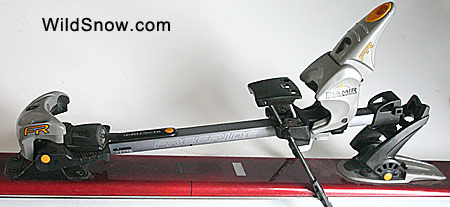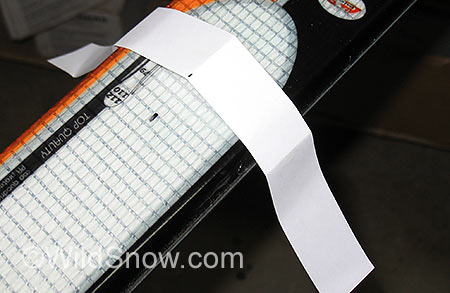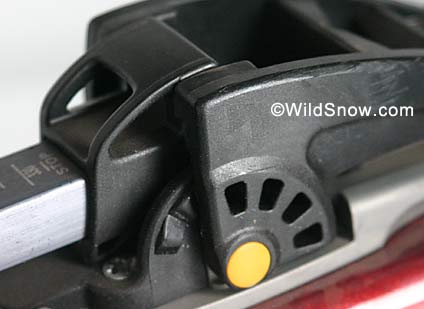How to Mount your Fritschi Diamir, Freeride, Freeride Plus, Explore, Express, Eagle OR ANY OTHER FRAME TYPE FRITSCHI Backcountry Skiing Bindings
IN CASE YOU LANDED HERE LOOKING FOR DIAMIR VIPEC MOUNTING, JUST USE THE GENERAL GUIDELINES HERE ALONG WITH OUR VIPEC TEMPLATE. CHECK TEMPLATE DIMENSIONS BEFORE DRILLING BY MATCHING TO BINDING AS WELL AS USING REFERENCE DIMENSIONS PRINTED ON TEMPLATE.
Disclaimer: By using these mounting instructions and templates, you agree to not hold Wildsnow.com, its owners or associates liable for anything.
Backcountry skiing bindings based on the “plate” design, such as most Fritschi models (Freeride, Diamir, Titanal, Explore, Express), are easy to mount at home. Take care to locate the binding in the correct for/aft position on the ski, be sure the binding is centered left/right, position the heel unit correctly — and you’re good to go.

Typical Fritschi Diamir frame binding.
To mount your Fritschi backcountry skiing bindings at home, follow the directions below and use our PDF mounting template. Our standard template works with most Fritschi bindings, including the Freeride and Freeride plus. The 2006 Explore model has a slight manufacturing variation in the front/back spacing of the front screw holes (about 1/2 millimeter) and we compensate for that with a slightly different template. Eagle requires its own template. When you print template, take care with your print scaling settings so the screw holes match. Set to “no scaling,” or “100 %” and so forth. More about this on the template. Links below:
Download standard template for most Fritsch bindings.
Download slightly different template for 2006 Explore.
Download EAGLE & Freeride Pro template.
(Warning: After downloading and printing template, compare to screw hole patterns on actual binding, as printing can sometimes distort the layout. If the holes don’t match, tweak printer settings such as scaling, which should usually be set to 100% or possibly “no scaling.”)
The keys to success with home ski binding mounts are careful measurement, going slow, and using the binding and paper template as a substitute for the mechanical jig used by a shop. Also, if you’re new to ski work we consider it to be essential that you do dummy mount on a pair of dumpster skis or a wood 2×4.
Disclaimer: By using these mounting instructions and templates, you agree to not hold Wildsnow.com, its owners or associates liable for anything.
What I’m presenting here is one of many ways a craftsman could achieve a good back country skiing binding mount. If you’re comfortable with tools and measurements, you’ll probably figure out a few variations along the way. Whatever you do, remember the idea is to center the bindings left/right on the ski, and locate the boot so it matches the boot location mark on the ski.
How to do the deed:
First, you need a good workbench or kitchen counter. Cover your counters with something liked taped butcher paper, but leave the outside edge exposed in case you want to use if for reference. Tools and materials needed:
Handheld screwdriver with pozi-drive bit to fit screws that come with the binding (with care you can use a jumbo philips bit, but pozi is much better*.)
Electric drill with sharp 5/32 inch bit*
Electrical tape and clear office tape, and of course some duct tape
Sharp center-punch, with associated hammer
Long straight steel ruler (wooden yardstick is not straight enough)
Tape measure
Fine point Sharpie type marker
One-hour epoxy
Paper template (see links above)
Scissors
Step 1 Make sure you know where the mounting mark (aka “sole midpoint”) is on your boots. It is usually a small vertical line, arrow, or triangle molded into the side of the sole midway between heel and toe. If your boot doesn’t have the mark, compare to another boot of the same size that has the mark, and transfer the mark. Or, as these marks are simply half the distance between toe and heel of the boot, just locate it by measurement. Enhance the mark with your Sharpie so you can’t miss it.
Step 2 Locate boot mounting mark on skis, this is the mark made on the skis when they are manufactured. Almost every ski made has a mounting mark, but some do not. If not, contact manufacturer customer service for binding location specifications. Enhance this mark with your Sharpie if it’s minimal.
Step 3 Using careful measurement, draw a LONG. tip/tail oriented center line on both skis in the binding mounting area. This line is used to align the template, and should extend a good distance past the front and rear of the binding.
A good way to find left/right center of a ski is to use folded paper. To do so simply wrap a strip of paper around the ski, crease it over the sharp steel base edges, remove and fold in half using the edge marks as reference, then place back on ski and use the crease to locate center. While this method is simple, work carefully (mainly, mark the spot on your ski where you place the paper, as moving it towards the tip or tail will throw things off because of the ski’s varied width.)
Connect your left/right center marks with a your long ruler or straightedge and draw an accurate line using the edge of the straightedge as a guide. The idea is to create a long mark down the center of each backcountry ski in the binding mount area (in the tip/tail direction). Be sure this mark is long enough to go well past the mounting area of both front and rear binding units.

Using paper strip to find ski center.
Step 4 Adjust binding for your boot and snap boot into binding.
Step 5 Set binding on ski, align boot mounting mark with that on ski.
Step 6 Near edge of ski, carefully mark the for/aft location of the front binding screw holes, so you can locate your template using the screw location lines on the template.
Step 7 Grab your other ski, lay both skis side-by-side. Using combination of measurement and straight edge, duplicate for/aft location of front screw holes on both skis. Hint, measure from tail with tape measure if you’re in doubt.
The idea here is that you’re using the frontmost screw holes as your template positioning reference — after you’ve matched up the boot/binding to the boot position mark on the ski.
Step 8 Download a template if you have not done so already (see above), and be sure the template prints correctly by comparison to actual screw holes in the binding. Cut template apart to separate toe and heel units, leave plenty of the tip/tail center line on template. If in doubt, download several copies of template so you can cut with plenty of extra center line. Cut template narrower than ski, so it fits on the ski and allows you to see the position location marks you made near the edge of the ski.
Step 9 Set template on ski, line up with center line, and line up front screw location lines with those you made near edge of ski. Tape template to ski.
Step 10 Double check. Set boot and binding plate combo on ski, on top of the template. Check that when backcountry skiing binding is aligned with template, your boot is still lined up with mark on ski.
Step 11 Using a thin sharp object, make small divots in paper template at marked screw locations. Grab your center punch, and using the small divots you made to help exact alignment of the punch, center punch your screw location with a few hammer taps on the punch.
Step 12 Chuck that sharp 5/32 bit in your drill. (Using a sharp drill bit prevents the bit from wandering sideways while you drill, use a special ski bit if possible, see bottom of page for drill bit information.) Place a screw in the binding (with the plastic shoe that goes under the toe unit) as if it were already in the ski, and use the protruding screw as a gage to to figure how deep you will drill. If necessary tape a depth stop to the drill bit by wrapping tightly with electrical tape to create the stop. Drill your center punch marks with minimal pressure, so you don’t mash the bit through a ski.
Step 13 Screw the binding to the ski using only two of the front screws. Lightly tighten the screws. Do not glue screws at this time as they need to be left a bit loose until you’re sure you’ve lined up the binding rail to the heel unit.
Heel Unit and Final Install of Front (Toe) Unit
This is the tricky part of mounting any Fritschi. There is no good rule-of-thumb or visual check that tells where to locate the heel unit. You have to use measurements from the front screws to the rear screws, per those shown on the template.
Step 1 Using the heel/toe separation measurement from the template, and an accurate steel rule, locate for/aft position of rear screw holes and mark this across ski. More than a millimeter off and your heel clamp may not work, so be careful!
(2006 Freeride Plus heel unit mount requires an extra screw to hold down the plastic plate. Locate this screw by first dry-mounting the heel unit, mark the additional screw location, remove binding from ski, drill hole, then do final mount of heel unit.)
Step 2 Lay the heel template on the ski, line up the center line, and align the left/right screw line with the mark on your skis. Tape template to ski.
Step 3 Drop binding plate down, and do a dry-run with the heel unit for a visual check, compare to photo here.

Detail of Fritschi Freeride heel unit in locked position. Before drilling holes in ski, dry fit this together, line up screw holes with template on ski, and make sure it matches position in photo.
Step 4 Once you’re satisfied with heel unit location, center punch screw locations, drill, put some epoxy in the holes then run the screws in and tighten.
Step 5 Now it’s time to align the binding front unit (toe and rail). You’ve got the binding front attached with just a couple of screws. First, re-install pair of screws with epoxy, but only gently tighten. Drop the binding rail down and see how the rear of the rail lines up with the heel unit. If it drops in without rubbing on either side it’s good — in that case start tightening the screws. If alignment continues to be good, give the two screws their final torque, then epoxy, insert and tighten the other screws, all the while checking for alignment of rail with heel unit.
If you find the binding rail is out of line a small amount to left or right (usually due to slight ms-alignment of toe unit screw holes), try simply holding binding rail over in correct direction while you tighten screws. If that doesn’t do it, remove some of the front screws and look for which screw holes line up the best with binding when the binding rail is aligned with the heel unit. Insert those screws first. These methods are usually all you need to get perfect alignment.
See our Fritschi Binding FAQ for more information.
Drill bits: Ski shops use special drill bits for drilling skis, usually 4.1 mm diameter for skis with metal layers, and 3.5 mm for skis without metal. If you mount a lot of backcountry skis, it’s a good idea to buy a selection of special drill bits from an outfit such as SlideWright. Along with such bits, buy a threading tool (tap) to thread the holes. In my experience, it’s okay to use the slightly larger 5/32 inch (3.9) mm) drill bit as suggested above, without a tap. If you do so, especially with non-metal skis, just be careful as you twist the screws in so you don’t over-tighten them and strip the holes, and use 1-hour epoxy in the holes since they’re slightly oversized. With skis that have a soft core and minimal binding mount reinforcement you can use the slightly smaller 9/64 inch (3.5 mm) drill bit size which is quite close to the standard ski drill size of 3.6 mm. To remove epoxied screws, lightly heat with soldering iron before twisting out, don’t use 5 minute epoxy as it’s brittle. Pozi screwdriver bits are also available from SlideWright, and mandatory if you want to do a decent job. Please see our article about ski drill bits.

8 comments
Thanks for sharing this, life saver…I picked up a pair of Freerides and the directions were spot on, was a little nervous undertaking it on my own, but no problem!
Hi Lou – thanks for the very quick reply!
The Vix bit set that I recently purchased has 9/64 + 11/64 and cost $13 for 7 bits ranging from 5/64 to 1/4″ (!). They have a setscrew which allows you to set the drill bit protrusion which thereby sets the drilling depth. If 5/32 is really needed, I bet swapping one into the 11/64 body would not introduce a huge centering error.
I plan to test on a pair of dumpster skis that I picked up, fitting a boot loaded binding to the ski. Clamping options are my woodworking Jorgensens or BIG clothespins. Tourniquet would be another option. Clamp, measure, tap with a mallet to adjust position and then drill.
One could also use double sided carpet tape, measuring carefully before pressing down to bond the tape. Once bonded, drill + screw the accessible holes, and the remove the boot to get the rest.
I’ll let you know how it goes…
Wayne I’m with Lou on the paper jig method as I’ve created numerous paper jigs over the decades to mount various AT bindings with 100% success save for when a stop doesn’t stop and the drill punches through the base:) Another challenge you may run into is having a straight shot into the hole as some bindings make that difficult. Also, using graph paper can be of benefit when creating you jig. God luck!
Wayne, I’m familiar with Vix bits, I still have a selection I used during my other career as a carpenter. I suppose your idea could work provided the bit was the correct size, had a depth stop, and you had a method of holding the binding on the ski in the exact position without it moving while drilling. In my opinion, using a paper jig taped to the ski, then center punching and drilling with ski drill-bit, is the better alternative. I suppose the depth stop problem could be solved by cutting the Vix bit shorter. Holding the binding on the ski in exact position would I think be the main challenge. Again, easier to just tape a paper template on the ski. If you try doing it with a Vix bit, let us know. Lou
Wouldn’t it be easier to use a self centering Vix type drill bit directly on the binding using the binding as the template? Vix bits have a retractable sleeve that centers the bit on the hole. They also have a way to set the drilling depth. They are commonly used for mounting door hinges, and are pretty cheap now at bigbox or Amazon.
Thanks for this!
HI, what about the Scout 11? M/L. Do you have a template for that one please? thank you
I have the same problem, but I was looking for a template for a S/M. The good thing about this shut-down is I now get to invest the time I’ve always wanted into learning computer aided drafting. I’ve made this template using measurements I took from the binding with my digital calipers. It works well enough that I was able to successfully practice mount the bindings using threaded inserts. I am attaching a link to a Google Drive file that will have the template and a picture. This is my first drafting project, so as always, individual results may vary.
https://drive.google.com/open?id=1yVwUJqkIhu0vq5T9Tv6-5Ylq8kdsrtJT